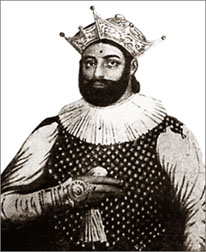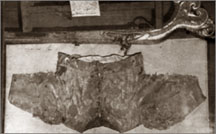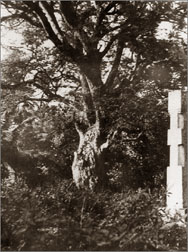Tree and stone pillar to be a tourist attraction
Today we recall King Sri Wickrema Rajasinghe's
capture at Mada Maha Nuwara 175 years ago...
The 175th death anniversary of the last King of Kandy Sri Wickrema
Rajasinghe fell on January 30. He was exiled to Vellore, India where he
died in 1832.
by Gamini G. Punchihewa
|

Sri Wickrema Rajasinghe - The last King of Ceylon
|
Sri Wickrema Rajasinghe - the last King of Kandy was captured at a
historic place called Mada Maha Nuwara nestling in the mist laden
Dumbara valley not far away from Kandy near Teldeniya and taken a
virtual prisoner on the ill-fated day of 18th February 1815 along with
his mother and two wives in the presence of Sir John D'Oly - the then
Resident of the Kandyan Provinces.
The King, his two wives and his mother at the time of their capture
had taken refuge in a house owned by Appurala Arachchi of Demure in
Udapitiyagedera in the vicinity of Mada Maha Nuwara. A commemorative
stone Pillar at Mada Maha Nuwara marks the historic but tragic spot
where the last king of Kandy and his royal household were captured by
the British troops.
Access to this historic landmark spot is through the premises of the
Mada Maha Nuwara Madyama Maha Vidyalaya, across some sprawling rice
fields. Close to this memorial stone pillar is a patriarch Tamarind tree
(siyambala gaha) with its gnarled knots well exposed - a living
testimony to its great antiquity in age.
Villagers say that this worn out siyambala tree had existed before
the memorial stone pillar was erected there & it is learnt that this
antiquated but historic tree and its environs are to be turned into a
tourist attraction by the authorities concerned.
Where the Hulu ganga meets the Mahaweli Ganga is still another
landmark connected with the capture of the last King.
|

Blood spattered jacket of the queen displayed at the National
Museum, Colombo, donated by K. N. T. Gunadasa of Karandana. |
It is wrapped in a woeful folk lone of how in a torturing way he was
alleged to have been taken along.
It was across this junction of these two rivers - Mahaweli Ganga and
Hulu Ganga that the Victoria Dam was constructed. In ancient times there
had been a ferry at this particular confluence of these two meandering
rivers - the Mahaweli Ganga and Hulu Ganga, called "Vel Lihutota"
meaning a ferry where the cords (taken from a jungle creeper) were
untied.
Sri Wickrema Rajasinghe, while being taken as a prisoner was bound
with wild creepers around his waist and was made to march in a torturous
way as if some animal was dragged whereupon the British soldiers, it is
said had felt pity on him and immediately the tied cords were untied at
this ancient ferry.
Hence thereafter the ferry came to be called 'Vel Lihuwatota'. It is
no more in existence, the old ferry got submerged with the construction
of the Victoria dam and its mighty reservoir.
Memorabilia at the Colombo National Museum
|

The commemorative decorative pillar at Mada Maha Nuwara in the
Dumbara Valley, marks the tragic spot where the last King of Kandy
was captured by the British.
|
The National Museum in Colombo, houses some fragments of the attire
worn by the queen at the time of her capture. On a name board etched are
the following pitiful words of how the jacket bore blood stain marks:
"Silk jacket to have been worn by the queen of His Majesty Sri Wickrema
Rajasinghe, the last King of Kandy at the time of her arrest in 1815".
The stain on the left bosom of the jacket is supposed to have been
due to the blood that had dripped down her ear when the earrings she had
worn were snatched away by one of the soldiers of the British Army. That
blood stained jacket was said to have been worn by the King's queen
named as Vankatha Rangamal.
In gleaning past information about King Rajasinghe's exploits, his
exile to Vellore in India and other episodes connected with it were
reproduced from my book- 'The Sandy River of History And Legend' (2000)
together with other vital information called from Henry Marshal's book
"A General Description of The Island of Ceylon and Its Territories"
(1845).
Quotes from my above quoted book: "In the same glass case was
preserved another memorabilia reminiscent of the deposed King Sri
Wickrema Rajasinghe. It reminds us of an act of Kindness shown by
Mudaliyar Don Adrian Wijesinghe Jayawardena who was the Gate Mudaliyar
to Mr. D'Oyley towards the King and his royal entourage at the time of
their capture during the journey to Colombo.
The ex-King had presented a gold watch to the Mudaliyar as a token of
gratitude. The following laudable words had been inscribed in the legend
encasing the gold watch: "Gold watch by the last King of Kandy was
presented to Mudaliyar Don Adrian Wijesinghe for acts of clemency and
kindness to the King and Queen while being conducted to Colombo under
captivity.
This watch was a present to the Sinhalese King by the King of Holland
and was in possession of the late Col. T. D. Jayawardane", "presented to
the Museum by T. F. Jayawardane Esqr." Incidentally it must be mentioned
that the late President of Sri Lanka, J. R. Jayawardene was a great
grandson of this dauntless Mudaliyar Don Adrian Wijesinghe the recipient
of the gold watch from the deposed last King of Kandy Sri Wickrema
Rajasinghe.
Since I had worked at the Mahaweli Centre, Colombo, as a Media
Officer (from 1986-91), I had ample opportunities in my official
travelling around the Mahaweli Project areas of historic and heritage
sites, when I visited this stone commemorative stone pillar erected
close to Mada Maha Nuwara and villagers living around.
Hence I was abe to collect vital information which are included in my
above quoted book. The next authoritative book I laid my hands on was
Henry's Marshal's above referred to book. Now let me quote the relevant
passages as given below: "As regards the donation of the royal jacket
worn by one of the queens - Venkatha Rangamal, Mr. K. N. D. Chandrasena,
son of the late Mr. K. N. T. Gunadasa of Karandana, a well known poet
and writer (in Sinhala) of the time of the Sabaragamuwa province who had
donated the jacket and the photograph (exhibited at the Colombo National
Museum) has further clarified the whole episode in his letter to the
'Sunday Observer' November 9, 1986.
His letter was in response to my article about the last King of Kandy
that had appeared in the Sunday Observer of 26.12 of 26.10.1986". "This
letter written by Mr. K. N. D. Chandrasena (son of the late Mr. K. N. T.
Karandana) who donated the jacket referred to above is also reproduced
below: (from my book - "The History and Legend of the Great Sandy
River"). "As son of Mr. K. N. T. Gunadasa of Karandana who was at one
time the principal of the Karandana Sri Jinarathana MV, I relate here
the story of the donation of the royal jacket".
"The jacket is believed to have been worn by Venkatha Rangamal the
Chief Queen of the last King of Kandy, Sri Wickrema Rajasinghe. The late
Ven. Rambukwella Siddharatha who was at one time a Lecturer of the
University College, Colombo came to know the existence of this jacket
from the late Ven. Karandana Sri Jinarathana Thera who was at that time
the Chief Incumbent of the Asokarama, Timbirigasyaya, an older brother
of Mr. Gunadasa.
Ven. Siddharatha on hearing this story had come to Karandana with Dr.
P. G. P. Deraniyagala, who was the then the Director of the National
Museums and subsequently my father had gifted it to the Museum, on
February 4, 1941.
My father had obtained this jacket from Kiriporuwe Punchi Bandara, a
grandson of Kiriporuwe Mohottala who is recorded as having accompanied
Ekneligoda Dissawe's forces who were responsible for the capture of Sri
Wickrema Rajasinghe".
King's journey in exile to Colombo
"From Kandy the deposed King was taken to Colombo on another malefic
day, 6th March 1815, where he remained until 24th January 1816, when he
sailed to Vellore in India with his two wives and retinue of attendants.
The House in Colombo where the King is supposed to have stayed for
some time had been demolished is supposed to have been in some army
barracks, where the King was taken as a prisoner till he was exiled to
India.
It is believed to have been in the premises presently occupied by the
Ceylinco House which epic spot was commemorated by the erection of the
King's statue with a fitting memorial plaque.
Those undying words run thus: "The last King of Sri Lanka - Sri
Wickrema Rajasinghe. This statue is erected to commemorate that he was
kept a prisoner in these premises after his capture by the British in
1815. Statue by Ariyawansa Weerakkody, artist and sculptor".
"Henry Marshal in his above quoted book says thus of the King's
voyage to Madras on his exile": "On the 24th January 1816, the King with
his family embarked at Colombo on board, H. A. 'ship Cornwall' for
Madras.
He was taken to the water-side in the Governor's carriage and his
ladies were accompanied with palanquins.
They were closely veiled as they went into the boat, and during their
embarkment which took some time, the King stood by and assisted giving
orders to his people, with much composure and presence of mind.
He was as very handsomely dressed and his large trousers drawn close
upon his ankles, reminded the spectators of the figure of Rajasinghe, as
given by Knox. The King embarked with his wives and mother-in-law, in
the Captains Barge and the attendants in another.
The wind was high and the boats encountered a good deal of sea in
their passage to the ship. They were all taken to the ship by means of
an accommodation - chair. Some of the ladies were greatly alarmed while
others suffered much from sea-sickness.
The King showed no indication of fear considering he was carried
through a rough sea, which he had not been upon since his infancy, to an
Englishman of war, which he had not seen before, it must be acknowledged
that his whole department indicated dignity and firmness of mind".
"The one last episode of the exile of the last King of Kandy, Sri
Wickrema Rajasinghe in connection with his, death which occurred in
Vellore on 30th January, 1832, at the age of 52 years.
Here is another account of it as told in Marshal's above quoted book:
"He died at Vellore on the afternoon of the 30th January, 1832, 52
years, having been 17 years a State prisoner.
At the desire of the family, the body was conveyed to the place of
burning before sun-set, under the escort of a military guard and
accompanied by his male relatives and servants". "His grave with a
memorial tomb still stands in Vellore". |
